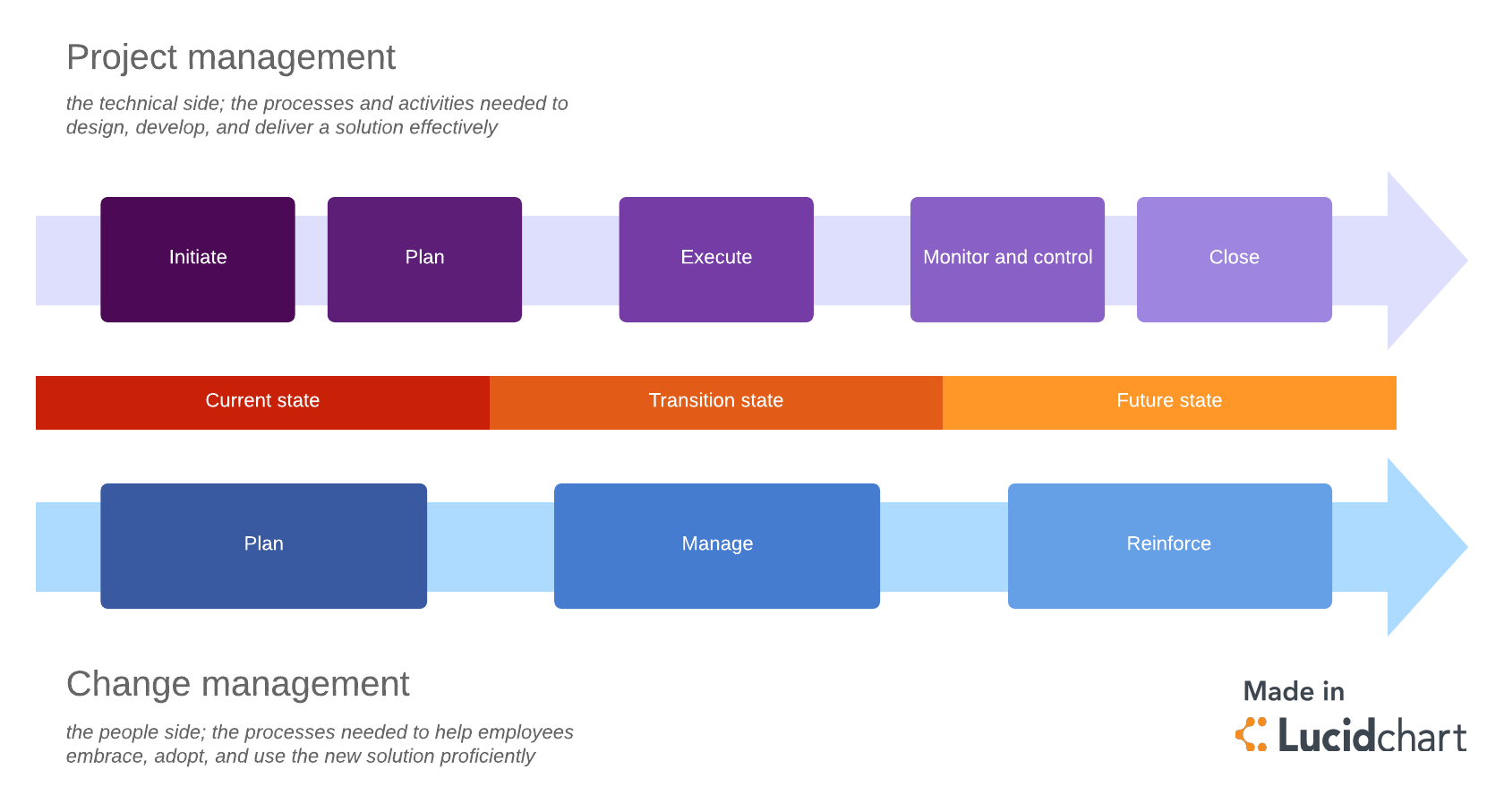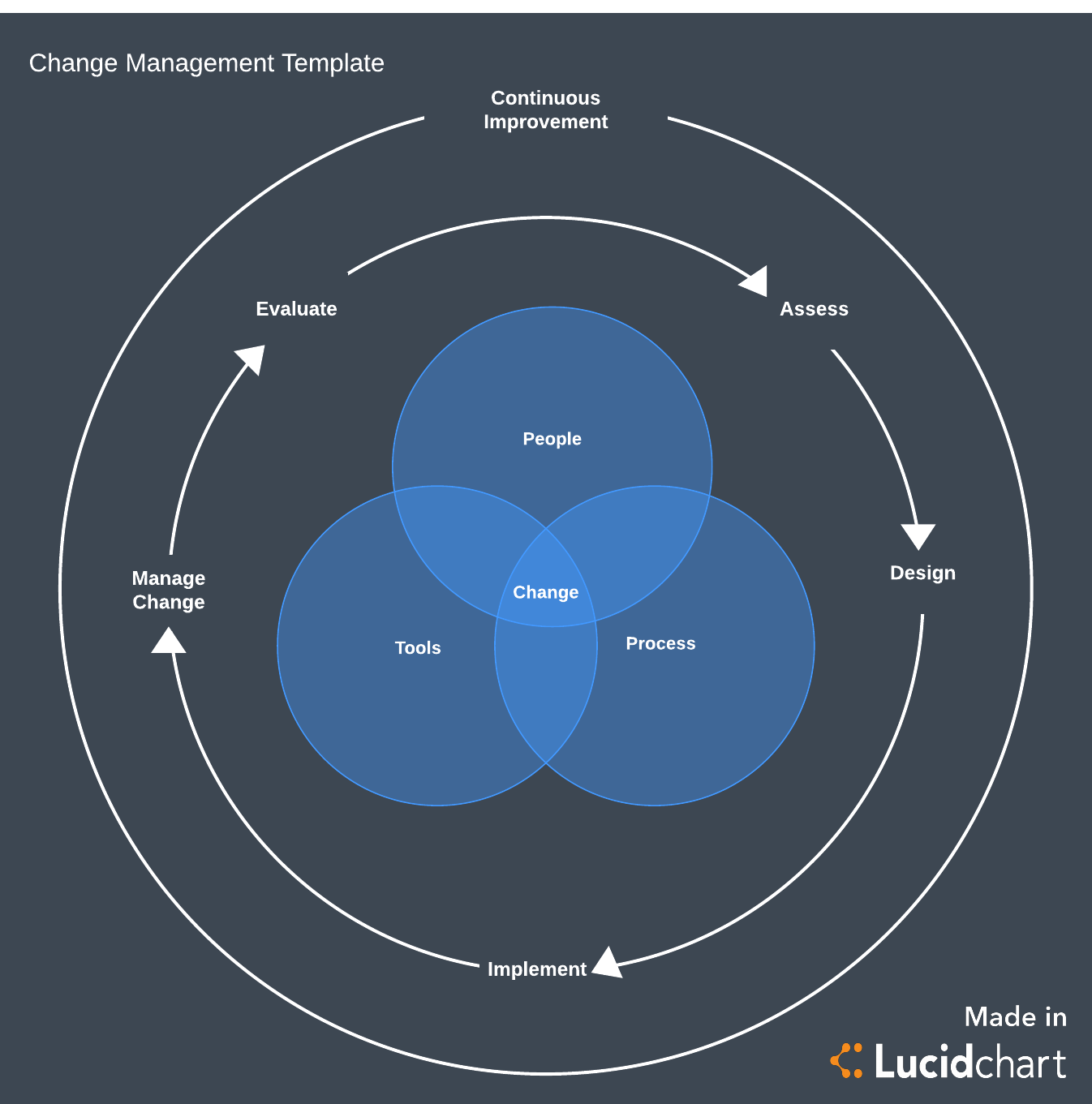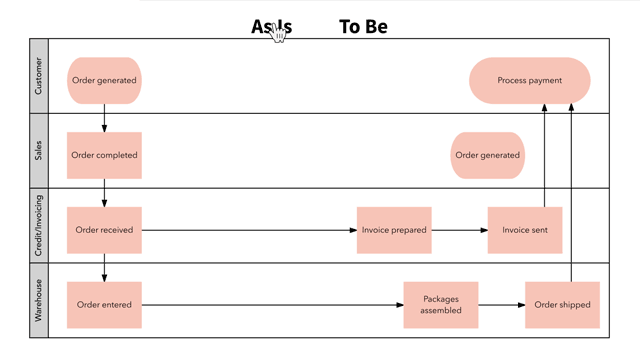
Understanding the difference between project management and change management
Lucid Content
Reading time: about 7 min
Topics:
Project management and change management are often confused. Although they both involve managing people and processes (and often work together to meet organizational goals), they are different disciplines.
Understanding what those differences are and how both practices can (and should) work together to manage projects and their resulting changes is crucial for the success of your organization.

What is project management?
The term “project management” can at once feel both obvious and vague. While most people intuitively understand what project management is, it’s useful to refer to the official definition.
The PMBOK guide describes project management as the application of knowledge, skills, tools, and techniques to meet project requirements. In other words, project management is about the process required to bring a team or product from point A to point B.
To do this, project managers and their teams manage processes within five main project stages:
- Initiating
- Planning
- Executing
- Monitoring and Controlling
- Closing
These stages help project managers organize the often overwhelming number of tasks and requirements of a project and strategically drive the project forward.
What is change management?
Whereas project management focuses on the processes and activities needed to complete a project (such as a new software application), change management focuses on the people affected by those projects (or other changes within the organization).
Because projects can have a significant and lasting impact on the business and its stakeholders, project and change management often work hand in hand to ensure a project’s long-term success.
So why exactly is change management necessary?
Project management teams focus primarily on fulfilling the strategic objectives of a project. While a team is often made up of stakeholders from various departments and backgrounds, the stakeholders on the team are not always able to address the impact the project may have on stakeholders outside of that “inner circle.”
This uncertainty can lead to anxiety, confusion, and resistance from the people on the ground who may not fully understand the need for the changes or how to adopt and adapt to new processes. Without buy-in from the rest of the organization, a project’s outcomes can be stunted.
Change management is the solution to this sticky problem.
Change managers help the people affected by a project to transition smoothly. They fulfill this goal through three process stages:
- Planning for change
- Managing change
- Reinforcing change
In many ways, change managers are the cheerleaders for a project. They must craft and deliver the messaging around the project and communicate the reason for the changes with employees and other stakeholders. Additionally, they will work with stakeholders to help them understand how those changes may impact different departments and roles and how to move forward effectively and efficiently.

Change management vs. project management
Even with a more in-depth description, it can be difficult to distinguish the specific differences between these two disciplines.
Here is a brief side-by-side look at how the two compare.
Change management:
- Has no standard guidelines
- Includes less formal processes
- Has no concrete timeline
- Puts focus on people
- Manages the impact of change resulting from organizational or project developments
Project management:
- Has well-documented guidelines and standards
- Follows a specific timeline
- Puts focus on technical processes and systems
- Manages the activities of a project to meet specific goals and requirements
Change management complements the project management process by supporting the human side of the equation.
How to incorporate both into your teams and processes
Because each discipline focuses on different aspects of a project (and ultimately its success), both project management and change management should work in tandem to ensure a project’s intended outcomes and overall organizational success.
Benefits of an integrated approach
Increased efficiency: Working independently of each other can lead to redundancies, miscommunication, and inefficiency. All of these factors result in messy implementation and subpar outcomes. When change and project management processes and teams integrate and work together, they can manage a project (and its impact) holistically and strategically.
Greater alignment: Integrating project management and change management in a project allows the teams to align their processes in the most effective and logical sequence. In other words, aligning the technical and people activities helps teams take the right action at the right time.
Risk mitigation: If both teams work in silos (or if change management is applied at the end of a project rather than from the beginning), they might miss significant risks and opportunities to manage and mitigate those issues.
For instance, change managers can identify areas where they expect greater pushback and resistance from stakeholders. When the two processes are integrated, managers can more effectively plan milestones and delivery.
Communication: In a similar vein, integrated project and change management improves communication and knowledge within the project. Change managers can ensure project management teams understand how people are reacting to the changes, and project managers can use that feedback to adapt their strategies and improve outcomes.
Tips for integrating change management and project management
There are different ways to incorporate change management into your project management practice. Whatever your approach, keep these tips in mind for greater success.
Align your goals and outcome objectives
Change management and project management naturally have complementary processes with the same basic underlying goal: to ensure the long-term success of a project (and its impact).
However, that shared goal can sometimes get lost if the two sides struggle to come together. Because change management is newer and follows a different pattern, it can be easy for the two groups to feel disconnected.
To prevent an “us vs. them” mentality, it is important for both teams to collaborate and clearly define and align their goals. Consider: What exactly are you trying to achieve? What are the desired outcomes?
By answering these questions, you can then get to work planning a strategic and dual approach to manage the project and its impact.
Establish structured change management processes
We noted above that the change management discipline does not follow strict guidelines or standard processes. However, for your change management integration to be successful, a structured approach is best.
Communicate with the project manager to decide on a practical methodology and process. The more rigorous and structured, the better. By following a defined process with clear objectives and milestones, you can more easily align that process with the project management timeline and ensure a more strategic application of activities.
Clearly define roles and responsibilities
Finally, it is crucial to sit down with both teams and hammer out who is responsible for what. Projects often take months to develop and implement. Make sure you know who is accountable for each activity or outcome throughout the process. That way, nothing gets lost in the shuffle, and everyone understands what to do and when.
By clearly defining responsibilities, you can not only improve your team effectiveness but also prevent delays from miscommunication and conflict.
Manage projects—and change—in Lucidchart
Managing change throughout a project is no small task. Luckily, Lucidchart can help. Lucidchart supports project and change managers as they document and track their processes from start to finish through visuals.
With a library of ready-made shapes, data linking and conditional formatting options, and real-time updates, Lucidchart can help you integrate your project management and change management processes with ease. Use Lucidchart to get at-a-glance insights into each team’s processes, identify areas of overlap, and visually combine the tasks into a cohesive process map.
Plus, you can diagram both your as-is and to-be processes to help all stakeholders within the organization understand the changes and their individual and collective impact.

Change is never easy. But with the right tools and the right approach, it can be successful. Sign up for Lucidchart today!
Sign up nowAbout Lucidchart
Lucidchart, a cloud-based intelligent diagramming application, is a core component of Lucid Software's Visual Collaboration Suite. This intuitive, cloud-based solution empowers teams to collaborate in real-time to build flowcharts, mockups, UML diagrams, customer journey maps, and more. Lucidchart propels teams forward to build the future faster. Lucid is proud to serve top businesses around the world, including customers such as Google, GE, and NBC Universal, and 99% of the Fortune 500. Lucid partners with industry leaders, including Google, Atlassian, and Microsoft. Since its founding, Lucid has received numerous awards for its products, business, and workplace culture. For more information, visit lucidchart.com.
Related articles
What is change management?
When employees have an informed and accurate understanding of what changes are happening and how they affect them, they can become proponents of those changes—and that’s the kind of momentum any organization can benefit from.
7 fundamental change management models
Change management generally refers to how teams and companies implement organizational change. Learn 7 tried-and-true change management models that organizations return to again and again.
